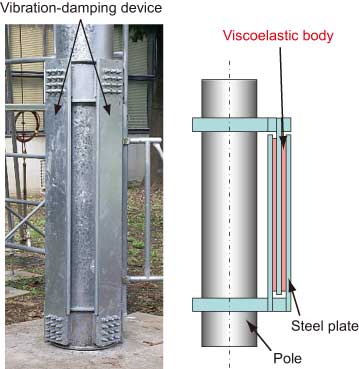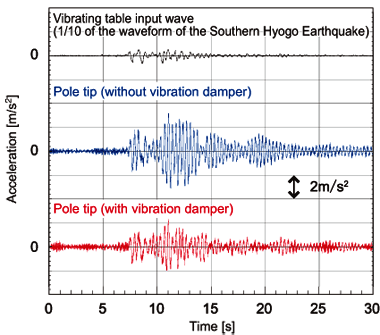12. Vibration-damping devices for catenary masts
- The RTRI developed a vibration-damping device for masts to improve aseismic capacity and suppress overhead contact line vibration.
- The device can be easily adapted to existing facilities.
Catenary poles supporting overhead contact lines oscillate in response to earthquakes and passing trains. In particular, if the natural frequencies of a viaduct and a pole are identical, resonance causes vibration to increase. This leads to a risk of poles breaking, overhead contact lines rupturing, and contact line fittings being damaged. Accordingly, RTRI developed a pole vibration-damping device to suppress vibration resulting from resonance by adding a damping function to masts in order to improve their aseismic capacity and dampen vibration in overhead contact lines.
The device is mounted on the lower part of poles and suppresses vibration by utilising their bending deformation. Since displacement in the lower part of poles is very small, no vibration-damping effect can be obtained using existing oil and other types of damper. Accordingly, this device was developed with a laminated structure in which a viscoelastic body is sandwiched by steel plates to exert a vibration-damping effect, even for low level displacement (Fig. 1). A design technique was also proposed to create an appropriate vibration-damping effect following theoretical study and basic testing with a 1/2-scale model, while considering workability and maintainability of the device once in place on the railway. This vibration-damping device has the advantages of being adaptable to single poles without work on the civil structures themselves, eliminating the need for fine adjustment during construction work, and offering a high level of weather resistance.
The results of a vibrating table test performed by mounting the device on an actual concrete pole confirmed that it reduced acceleration at the pole tip through its vibration-damping effect (Fig. 2). The proposed technique allows a design which complies with the required level of performance. It is particularly effective for locations where the natural frequencies of viaducts and poles are identical.
 Fig. 1 Vibration-damping device for poles
Fig. 1 Vibration-damping device for poles Fig. 2 Comparison of pole-tip vibration waveforms
Fig. 2 Comparison of pole-tip vibration waveforms